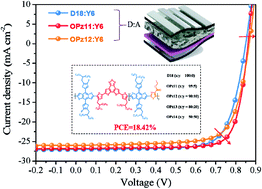18.42% efficiency polymer solar cells enabled by terpolymer donors with optimal miscibility and energy levels†
Abstract
The rapid development of non-fullerene acceptors (NFAs) has placed increasing demands on polymer donors and there is still room for optimization of the currently available top-performing polymer donors to work perfectly with the state-of-the-art NFAs. To further develop and fine-tune the best-performing polymer donors, random ternary copolymerization is a simple and powerful strategy, in which the search for a suitable and easily accessible third component is the challenge. Herein, a series of terpolymer donors OPz11, OPz12, OPz13 and OPz14 are synthesized by incorporating varying fractions of the ester-substituted thiazole (E-Tz) unit into the D18 polymer. Notably, the subtle E-Tz content brings optimization in the energy levels, electrostatic potentials (ESPs), molecular aggregation, miscibility and morphology, as revealed by the open circuit voltage (VOC) improvement from 856.1 to 865.3 mV, and fill-factor (FF) enhancement from 74.34% to 78.71%. Finally, an exciting power conversion efficiency (PCE) of 18.42% is obtained from OPz11:Y6 devices, and is among the highest values reported for PSCs. This work illustrates that the accessible E-Tz unit is a promising building block to construct terpolymer donors for high-performance organic photovoltaic cells, and random ternary copolymerization is a flexible and promising strategy for photovoltaic materials development.



 Please wait while we load your content...
Please wait while we load your content...